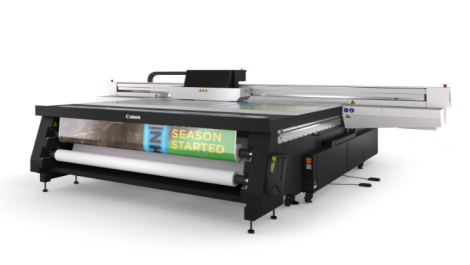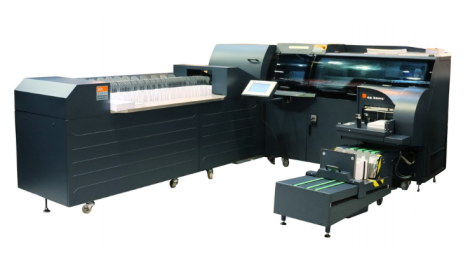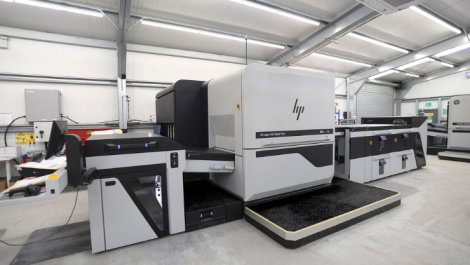Kodak is targeting the growing digital book printing market with its Prosper 1000 monochrome inkjet press. Nessan Cleary visits Sagim near Paris, which now has a year’s experience with the system.
In the last issue we looked at the first UK installation of Kodak’s colour inkjet press, the Prosper 5000 XL used by Howard Hunt for direct mail work, which clearly still has some issues over paper. But there seem to be no such problems with the closely related monochrome Prosper 1000. From the beginning Kodak said that it would tailor its Prosper presses for particular markets, so this black and white version is aimed fairly and squarely at book printing.
It’s a sector ideally suited to inkjet, with many book printers currently relying on offset for long runs and electrophotography for one-offs and reprints. Inkjet offers a single technology that can handle on-demand books as well as runs of a few thousand. As such the book sector is very attractive to all the inkjet vendors. There’s much talk that the future of digital book printing includes a move to colour, but there’s clearly still a large market for monochrome books. Prosper 1000s were steadily installed throughout the past year and although Kodak won’t confirm numbers, we think there are some 15 or more operating around the world.
First European installation
We recently visited the first European Prosper 1000 installation at Sagim, a French book printer based in Courtry, just outside Paris. Sagim started as a bookshop in the 1930s and later began to print business cards and then resistance papers during the war, before moving into book printing. It had been a family business but by 2002 it was bankrupt, and was taken over by the Italian firm Canale. Since 2009 it has been run by Guillaume de Courcy, who owns 15% of the company, the remainder held by Christian Devambez who also owns several other print companies. One of these does colour work, leaving Sagim free to concentrate on mono printing.
Mr De Courcy himself worked in sales from 1995 to 99, left to work for CPI in digital production, and then came back in 2003. He clearly sees the Prosper as a cost-effective way to get into high speed inkjet printing, allowing Sagim to hold its own against the much larger CPI group, which has invested in HP’s rival T300 inkjets.
Inkjet printing is particularly well suited to the French market, where many conventional printers use low cost Cameron belt press combination print and binding lines. Digital is more expensive but makes it possible to turn a book around much faster, which in turn reduces the warehousing costs to the publishers.
To illustrate this responsiveness, Mr De Courcy picks up a book on the French politician Christine Lagarde, who was voted in as the first female head of the International Monetary Fund last year. ‘Using the Prosper we reprinted the book the next day after she won the election,’ he said.
Unlike the Cameron press, inkjet also makes it possible to handle a wide variety of run lengths. As book printers know, it’s difficult to talk about average run lengths because many books sell just a few hundred, while others run into their thousands, and its often not easy to predict how popular a given book will be. Mr Devambez estimates that the Prosper should make it possible to handle run lengths from 300 to 2000.
Sagim already has two Variquik monochrome web offset presses, together with two Komori and KBA sheetfed offset presses, which have been used mainly to print covers in colour.
The Prosper 1000 was installed at the end of 2010 and has been running production jobs since January 2011. In contrast to the enormous HP T300 inkjets the Prosper seems tiny, almost dwarfed by the rolls of paper surrounding it in the factory. Mr De Courcy says that the Prosper is better suited to his business: ‘The HP machine is very big so it’s hard to change the paper. There is about 50 metres of paper in the press. Also we can use the same width of paper as our offset machines.’
Interestingly, Sagim opted not to use a precoater. Mr De Courcy says this sometimes causes problems with poorer quality offset papers: ‘The offset paper is much bulkier so the ink doesn’t go into it.’ He explains that the final image quality is very dependent on the quality of the paper that is used: ‘We are working with an ink which is very liquid to be able to run at very high speed and so a lot of the ink is going inside the paper so sometimes the printing is too grey. Also it’s down to the quality of the paper. It’s not such a problem with a low quality paper. But the high quality paper is very expensive and publishers don’t like to spend a lot.’
However, it would appear that the monochrome press can handle a very wide range of paper stocks, far wider than the full-colour Prosper, presumably because black and white text generally uses less ink coverage than most colour jobs, so there is no problem with drying the ink.
More expensive papers give better results but customers understand this and appear happy with the quality that they can achieve for a given price point. But this makes it difficult to quantify the run lengths the press can handle cost-effectively because the paper costs can vary enormously from one stock to another.
The digital books that Sagim has printed show the press can handle greyscale images as well as text. Mr De Courcy said: ‘It’s easier to make pictures than text. Some pictures, such as with a lot of light grey, I can do without trying where I would struggle with offset at the same 200 metres per minute.’
For finishing, Sagim has opted for a Hunkeler plod folder inline with the press, producing book blocks. Mr De Courcy said: ‘Then the book block goes to the binding machine. We don’t want to have the complete book inline because we want to be able to decide what binding to be used. If we have it all inline then there will be only one solution.’ He added: ‘The inline binding solution is very expensive and we already have a binding line which is in order, so I save a million Euros by just pushing a pallet over. It adds 10 to 15 minutes more to the production but it’s not important for runs of up to 2500.’
Conclusion
As book printers go, Sagim is a very small company, so investing in an expensive press like the Prosper is quite a gamble (its UK price is about £1 million). Yet Mr De Courcy is confident in the technology and has benefited from Kodak’s desire to find a European beta site in order to strike a good deal.
The print results we saw are excellent and Sagim is able to cope with a wide range of different paper stocks. It is true that the image quality varies considerably from one stock to another, but so to do the customers’ requirements, with some publishers preferring heavy black type while others like grey text, so this is not a problem. The one thing they all want is low costs and fast turnaround and this the Prosper delivers, allowing this small printer to compete against much larger companies over a range of run lengths.
Have toner presses hit their limits?
While web fed digital on-demand book printers have been around for a couple of decades, the first generations were all based on dry toners. Reel fed laser electrophotography was favoured by Océ, Hitachi/IBM (now InfoPrint/Ricoh) and Xerox. Delphax and Nipson developed unique imaging systems for their fast toner lines, using ion deposition and magnetography respectively.
All these technologies seem to have pretty well hit their speed limits and most of their developers evidently see inkjet as the way ahead.
Océ has announced three new monochrome JetStream inkjet book printers to boost speed potential beyond its toner VarioStreams and compete with HP and Kodak inkjets (see Centrefold p20 – 21).
InfoPrint still offers the 4100 fast web toner printer for monochrome book work, but its 5000 inkjet can be configured for black-only, though it’s mainly used for transactional work.
Xerox’s new CiPress 500 web fed solid ink colour printer may also have mono book potential – it’s certainly built for printing on cheap uncoated stocks.
Delphax announced an intriguing deal last year to build a new colour inkjet printer, based on the high speed low cost Memjet heads. This will be revealed at drupa. From what little has been said so far it will be a fast sheetfed machine, with books as one of its claimed markets. However, Delphax has not so far said what the format will be.
Nipson has been a bit quiet since its acquisition by Punch Graphix a couple of years ago, but it has already shown inkjet colour add-ons for its established magnetography lines.




